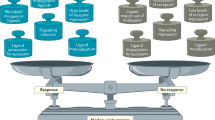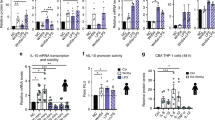Abstract
The expression and activation of Toll-like receptors (TLRs) was investigated in leprosy, a spectral disease in which clinical manifestations correlate with the type of immune response mounted toward Mycobacterium leprae. TLR2-TLR1 heterodimers mediated cell activation by killed M. leprae, indicating the presence of triacylated lipoproteins. A genome-wide scan of M. leprae detected 31 putative lipoproteins. Synthetic lipopeptides representing the 19-kD and 33-kD lipoproteins activated both monocytes and dendritic cells. Activation was enhanced by type-1 cytokines and inhibited by type-2 cytokines. In addition, interferon (IFN)-γ and granulocyte-macrophage colony-stimulating factor (GM-CSF) enhanced TLR1 expression in monocytes and dendritic cells, respectively, whereas IL-4 downregulated TLR2 expression. TLR2 and TLR1 were more strongly expressed in lesions from the localized tuberculoid form (T-lep) as compared with the disseminated lepromatous form (L-lep) of the disease. These data provide evidence that regulated expression and activation of TLRs at the site of disease contribute to the host defense against microbial pathogens.
This is a preview of subscription content, access via your institution
Access options
Subscribe to this journal
Receive 12 print issues and online access
$209.00 per year
only $17.42 per issue
Buy this article
- Purchase on Springer Link
- Instant access to full article PDF
Prices may be subject to local taxes which are calculated during checkout






Similar content being viewed by others
References
Brightbill, H.D. et al. Host defense mechanisms triggered by microbial lipoproteins through Toll-like receptors. Science 285, 732–736 (1999).
Aliprantis, A.O. et al. Cell activation and apoptosis by bacterial lipoproteins through Toll-like receptor-2. Science 285, 736–739 (1999).
Takeuchi, O. et al. Role of TLR1 in mediating immune response to microbial lipoproteins. J. Immunol. 169, 10–14 (2002).
Alexopoulou, L. et al. Hyporesponsiveness to vaccination with Borrelia burgdorferi OspA in humans and in TLR1- and TLR2-deficient mice. Nat. Med. 8, 878–884 (2002).
Alexopoulou, L., Holt, A.C., Medzhitov, R. & Flavell, R.A. Recognition of double-stranded RNA and activation of NF-κB by Toll-like receptor 3. Nature 413, 732–738 (2001).
Yang, R.B. et al. Toll-like receptor-2 mediates lipopolysaccharide-induced cellular signalling. Nature 395, 284–288 (1998).
Poltorak, A. et al. Defective LPS signaling in C3H/HeJ and C57BL/10ScCr mice: mutations in Tlr4 gene. Science 282, 2085–2088 (1998).
Takeuchi, O. et al. Differential roles of TLR2 and TLR4 in recognition of gram-negative and gram-positive bacterial cell wall components. Immunity 11, 443–451 (1999).
Hayashi, F. et al. The innate immune response to bacterial flagellin is mediated by Toll- like receptor 5. Nature 410, 1099–1103 (2001).
Takeuchi, O. et al. Discrimination of bacterial lipoproteins by Toll-like receptor 6. Int. Immunol. 13, 933–940 (2001).
Hemmi, H. et al. Small anti-viral compounds activate immune cells via the TLR7 MyD88- dependent signaling pathway. Nat. Immunol. 3, 196–200 (2002).
Jurk, M. et al. Human TLR7 or TLR8 independently confer responsiveness to the antiviral compound R-848. Nat. Immunol. 3, 499 (2002).
Hemmi, H. et al. A Toll-like receptor that recognizes bacterial DNA. Nature 408, 740–745 (2000).
Medzhitov, R., Preston-Hurlburt, P. & Janeway, C.A.J. A human homologue of the Drosophila Toll protein signals activation of adaptive immunity. Nature 388, 394–397 (1997).
Thoma-Uszynski, S. et al. Induction of direct antimicrobial activity through mammalian toll-like receptors. Science 291, 1544–1547 (2001).
Ridley, D.S. & Jopling, W.H. Classification of leprosy according to immunity. A five-group system. Int. J. Lepr. 34, 255–273 (1966).
Yamamura, M. et al. Defining protective responses to pathogens: cytokine profiles in leprosy lesions. Science 254, 277–279 (1991).
Salgame, P. et al. Differing lymphokine profiles of functional subsets of human CD4 and CD8 T cell clones. Science 254, 279–282 (1991).
Maeda, Y. et al. Novel 33-kilodalton lipoprotein from Mycobacterium leprae. Infect. Immun. 70, 4106–4111 (2002).
Staege, H., Schaffner, A. & Schneemann, M. Human toll-like receptors 2 and 4 are targets for deactivation of mononuclear phagocytes by interleukin-4. Immunol. Lett. 71, 1–3 (2000).
Sieling, P.A. et al. IL-12 regulates T helper type 1 cytokine responses in human infectious disease. J. Immunol. 153, 3639–3647 (1994).
Garcia, V.E. et al. IL-18 promotes type 1 cytokine production from NK cells and T cells in human intracellular infection. J. Immunol. 162, 6114–6121 (1999).
Flo, T.H. et al. Differential expression of Toll-like receptor 2 in human cells. J. Leukoc. Biol. 69, 474–481 (2001).
O'Brien, A.D. et al. Genetic control of susceptibility to Salmonella typhimurium in mice: role of the LPS gene. J. Immunol. 124, 20–24 (1980).
Anderson, G.W.J. & Osterman, J.V. Host defenses in experimental rickettsialpox: genetics of natural resistance to infection. Infect. Immun. 28, 132–136 (1980).
Cross, A. et al. The importance of a lipopolysaccharide-initiated, cytokine-mediated host defense mechanism in mice against extraintestinally invasive Escherichia coli. J. Clin. Invest. 96, 676–686 (1995).
Weinstein, D.L., Lissner, C.R., Swanson, R.N. & O'Brien, A.D. Macrophage defect and inflammatory cell recruitment dysfunction in Salmonella susceptible C3H/HeJ mice. Cell. Immunol. 102, 68–77 (1986).
Medina, E. & North, R.J. Resistance ranking of some common inbred mouse strains to Mycobacterium tuberculosis and relationship to major histocompatibility complex haplotype and Nramp1 genotype. Immunology 93, 270–274 (1998).
Takeuchi, O., Hoshino, K. & Akira, S. Cutting edge: TLR2-deficient and MyD88-deficient mice are highly susceptible to Staphylococcus aureus infection. J. Immunol. 165, 5392–5396 (2000).
Wang, X. et al. Toll-like receptor 4 mediates innate immune responses to Haemophilus influenzae infection in mouse lung. J. Immunol. 168, 810–815 (2002).
Wooten, R.M. et al. Toll-like receptor 2 is required for innate, but not acquired, host defense to Borrelia burgdorferi. J. Immunol. 168, 348–355 (2002).
Kang, T.J. & Chae, G.T. Detection of Toll-like receptor 2 (TLR2) mutation in the lepromatous leprosy patients. FEMS Immunol. Med. Microbiol. 31, 53–58 (2001).
Aliprantis, A.O., Yang, R.B., Weiss, D.S., Godowski, P. & Zychlinsky, A. The apoptotic signaling pathway activated by Toll-like receptor-2. EMBO J. 19, 3325–3336 (2000).
Cole, S.T. et al. Massive gene decay in the leprosy bacillus. Nature 409, 1007–1011 (2001).
Cole, S.T. et al. Deciphering the biology of Mycobacterium tuberculosis from the complete genome sequence. Nature 393, 537–544 (1998).
Post, F.A. et al. Mycobacterium tuberculosis 19-kilodalton lipoprotein inhibits Mycobacterium smegmatis-induced cytokine production by human macrophages in vitro. Infect. Immun. 69, 1433–1439 (2001).
Yeremeev, V.V. et al. Deletion of the 19kDa antigen does not alter the protective efficacy of BCG. Tubercle Lung Dis. 80, 243–247 (2000).
Means, T.K. et al. Human Toll-like receptors mediate cellular activation by Mycobacterium tuberculosis. J. Immunol. 163, 3920–3927 (1999).
Means, T.K. et al. The CD14 ligands lipoarabinomannan and lipopolysaccharide differ in their requirement for Toll-like receptors. J. Immunol. 163, 6748–6755 (1999).
Hirschfeld, M., Ma, Y., Weis, J.H., Vogel, S.N. & Weis, J.J. Cutting edge: repurification of lipopolysaccharide eliminates signaling through both human and murine toll-like receptor 2. J. Immunol. 165, 618–622 (2000).
Takeuchi, O. et al. Cutting edge: preferentially the R-stereoisomer of the mycoplasmal lipopeptide macrophage-activating lipopeptide-2 activates immune cells through a toll-like receptor 2- and MyD88-dependent signaling pathway. J. Immunol. 164, 554–557 (2000).
Bairoch, A., Bucher, P. & Hofmann, K. The PROSITE database, its status in 1997. Nucleic Acids Res. 25, 217–221 (1997).
Monney, L. et al. Th1-specific cell surface protein Tim-3 regulates macrophage activation and severity of an autoimmune disease. Nature 415, 536–541 (2002).
Modlin, R.L. et al. In situ identification of cells in human leprosy granulomas with monoclonal antibodies to interleukin 2 and its receptor. J. Immunol. 132, 3085–3090 (1984).
Stenger, S. et al. An antimicrobial activity of cytolytic T cells mediated by granulysin. Science 282, 121–125 (1998).
Ochoa, M.T. et al. T-cell release of granulysin contributes to host defense in leprosy. Nat. Med. 7, 174–179 (2001).
Acknowledgements
We thank D. Williams and T. Gillis (National Hansen's Disease Programs) for use of their unpublished data on expression of ML1966 mRNA, W. Chung for technical assistance and S. Smale for critical comments on the manuscript and scientific discussion. This work was supported in part by grants from the National Institutes of Health (AI07126, AI22553 and AI47866) and the World Health Organization (IMMLEP).
Author information
Authors and Affiliations
Corresponding author
Ethics declarations
Competing interests
The authors declare no competing financial interests.
Supplementary information
Rights and permissions
About this article
Cite this article
Krutzik, S., Ochoa, M., Sieling, P. et al. Activation and regulation of Toll-like receptors 2 and 1 in human leprosy. Nat Med 9, 525–532 (2003). https://doi.org/10.1038/nm864
Received:
Accepted:
Published:
Issue Date:
DOI: https://doi.org/10.1038/nm864
This article is cited by
-
A vaccine-based nanosystem for initiating innate immunity and improving tumor immunotherapy
Nature Communications (2020)
-
The influence of innate and adaptative immune responses on the differential clinical outcomes of leprosy
Infectious Diseases of Poverty (2017)
-
Combinatorial code governing cellular responses to complex stimuli
Nature Communications (2015)



